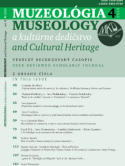“Bones in the sandbox”: museum as “world picture” vs. museum as “lifeworld”
“Bones in the sandbox”: museum as “world picture” vs. museum as “lifeworld”
Author(s): Vladimir Plokhotnyuk, Irina Przhilenskaya, Vladimir PrzhilenskiySubject(s): Archaeology, Museology & Heritage Studies, Ancient World, Contemporary Philosophy, Philosophy of Science, Prehistory
Published by: Univerzita Komenského v Bratislave, Filozofická fakulta
Keywords: southern mammoth skeleton; palaeontology; museum exhibit presentation; interpretation; Heidegger; world picture;
Summary/Abstract: This article deals with the issues of museum communication and interpretation of museum exhibits in a philosophical and cultural context. As an example, it considers two different ways of presenting palaeontological material – specifically, the skeleton of a southern mammoth – revealing differences in how the semantic content is interpreted. The first method – the traditional approach of assembling the skeleton – gives a “world picture” of a certain era, as it appears to a palaeontologist. The second approach presents the skeleton in a “sandbox”, representing how it was found during excavations, such that viewers deal not with the interpreted “ready-made” material, but with the contemporary experienced reality – the “life-world”, the “raw” source material. This allows visitors to realize their own creative potential and to recreate the nature of the Pleistocene epoch in their imagination. Thus, through the mutual correlation of the roles exhibition’s author and of the visitor as an interpreter, the semantic field of museum communication expands. In Heidegger’s conception, a “picture of the world” hides the world rather than explains it, while the “life world” represents it as it is.
Journal: Muzeológia a kultúrne dedičstvo
- Issue Year: 8/2020
- Issue No: 4
- Page Range: 23-34
- Page Count: 12
- Language: English

